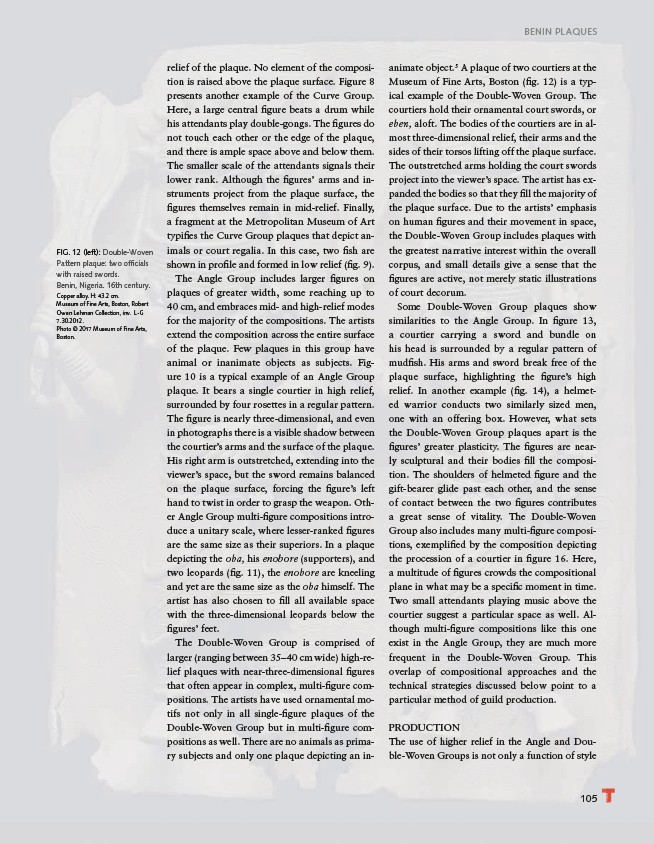
BENIN PLAQUES
105
FIG. 12 (left): Double-Woven
Pattern plaque: two offi cials
with raised swords.
Benin, Nigeria. 16th century.
Copper alloy. H: 43.2 cm.
Museum of Fine Arts, Boston, Robert
Owen Lehman Collection, inv. L-G
7.30.2012.
Photo © 2017 Museum of Fine Arts,
Boston.
relief of the plaque. No element of the composition
is raised above the plaque surface. Figure 8
presents another example of the Curve Group.
Here, a large central fi gure beats a drum while
his attendants play double-gongs. The fi gures do
not touch each other or the edge of the plaque,
and there is ample space above and below them.
The smaller scale of the attendants signals their
lower rank. Although the fi gures’ arms and instruments
project from the plaque surface, the
fi gures themselves remain in mid-relief. Finally,
a fragment at the Metropolitan Museum of Art
typifi es the Curve Group plaques that depict animals
or court regalia. In this case, two fi sh are
shown in profi le and formed in low relief (fi g. 9).
The Angle Group includes larger fi gures on
plaques of greater width, some reaching up to
40 cm, and embraces mid- and high-relief modes
for the majority of the compositions. The artists
extend the composition across the entire surface
of the plaque. Few plaques in this group have
animal or inanimate objects as subjects. Figure
10 is a typical example of an Angle Group
plaque. It bears a single courtier in high relief,
surrounded by four rosettes in a regular pattern.
The fi gure is nearly three-dimensional, and even
in photographs there is a visible shadow between
the courtier’s arms and the surface of the plaque.
His right arm is outstretched, extending into the
viewer’s space, but the sword remains balanced
on the plaque surface, forcing the fi gure’s left
hand to twist in order to grasp the weapon. Other
Angle Group multi-fi gure compositions introduce
a unitary scale, where lesser-ranked fi gures
are the same size as their superiors. In a plaque
depicting the oba, his enobore (supporters), and
two leopards (fi g. 11), the enobore are kneeling
and yet are the same size as the oba himself. The
artist has also chosen to fi ll all available space
with the three-dimensional leopards below the
fi gures’ feet.
The Double-Woven Group is comprised of
larger (ranging between 35–40 cm wide) high-relief
plaques with near-three-dimensional fi gures
that often appear in complex, multi-fi gure compositions.
The artists have used ornamental motifs
not only in all single-fi gure plaques of the
Double-Woven Group but in multi-fi gure compositions
as well. There are no animals as primary
subjects and only one plaque depicting an inanimate
object.5 A plaque of two courtiers at the
Museum of Fine Arts, Boston (fi g. 12) is a typical
example of the Double-Woven Group. The
courtiers hold their ornamental court swords, or
eben, aloft. The bodies of the courtiers are in almost
three-dimensional relief, their arms and the
sides of their torsos lifting off the plaque surface.
The outstretched arms holding the court swords
project into the viewer’s space. The artist has expanded
the bodies so that they fi ll the majority of
the plaque surface. Due to the artists’ emphasis
on human fi gures and their movement in space,
the Double-Woven Group includes plaques with
the greatest narrative interest within the overall
corpus, and small details give a sense that the
fi gures are active, not merely static illustrations
of court decorum.
Some Double-Woven Group plaques show
similarities to the Angle Group. In fi gure 13,
a courtier carrying a sword and bundle on
his head is surrounded by a regular pattern of
mudfi sh. His arms and sword break free of the
plaque surface, highlighting the fi gure’s high
relief. In another example (fi g. 14), a helmeted
warrior conducts two similarly sized men,
one with an offering box. However, what sets
the Double-Woven Group plaques apart is the
fi gures’ greater plasticity. The fi gures are nearly
sculptural and their bodies fi ll the composition.
The shoulders of helmeted fi gure and the
gift-bearer glide past each other, and the sense
of contact between the two fi gures contributes
a great sense of vitality. The Double-Woven
Group also includes many multi-fi gure compositions,
exemplifi ed by the composition depicting
the procession of a courtier in fi gure 16. Here,
a multitude of fi gures crowds the compositional
plane in what may be a specifi c moment in time.
Two small attendants playing music above the
courtier suggest a particular space as well. Although
multi-fi gure compositions like this one
exist in the Angle Group, they are much more
frequent in the Double-Woven Group. This
overlap of compositional approaches and the
technical strategies discussed below point to a
particular method of guild production.
PRODUCTION
The use of higher relief in the Angle and Double
Woven Groups is not only a function of style